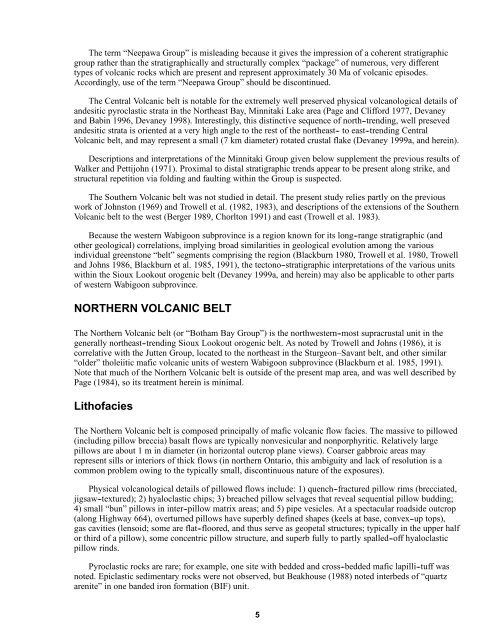Regional Geology, Sioux Lookout Orogenic Belt - Geology Ontario
Regional Geology, Sioux Lookout Orogenic Belt - Geology Ontario
Regional Geology, Sioux Lookout Orogenic Belt - Geology Ontario
You also want an ePaper? Increase the reach of your titles
YUMPU automatically turns print PDFs into web optimized ePapers that Google loves.
The term “Neepawa Group” is misleading because it gives the impression of a coherent stratigraphic<br />
group rather than the stratigraphically and structurally complex “package” of numerous, very different<br />
types of volcanic rocks which are present and represent approximately 30 Ma of volcanic episodes.<br />
Accordingly, use of the term “Neepawa Group” should be discontinued.<br />
The Central Volcanic belt is notable for the extremely well preserved physical volcanological details of<br />
andesitic pyroclastic strata in the Northeast Bay, Minnitaki Lake area (Page and Clifford 1977, Devaney<br />
and Babin 1996, Devaney 1998). Interestingly, this distinctive sequence of north--trending, well preseved<br />
andesitic strata is oriented at a very high angle to the rest of the northeast-- to east--trending Central<br />
Volcanic belt, and may represent a small (7 km diameter) rotated crustal flake (Devaney 1999a, and herein).<br />
Descriptions and interpretations of the Minnitaki Group given below supplement the previous results of<br />
Walker and Pettijohn (1971). Proximal to distal stratigraphic trends appear to be present along strike, and<br />
structural repetition via folding and faulting within the Group is suspected.<br />
The Southern Volcanic belt was not studied in detail. The present study relies partly on the previous<br />
work of Johnston (1969) and Trowell et al. (1982, 1983), and descriptions of the extensions of the Southern<br />
Volcanic belt to the west (Berger 1989, Chorlton 1991) and east (Trowell et al. 1983).<br />
Because the western Wabigoon subprovince is a region known for its long--range stratigraphic (and<br />
other geological) correlations, implying broad similarities in geological evolution among the various<br />
individual greenstone “belt” segments comprising the region (Blackburn 1980, Trowell et al. 1980, Trowell<br />
and Johns 1986, Blackburn et al. 1985, 1991), the tectono--stratigraphic interpretations of the various units<br />
within the <strong>Sioux</strong> <strong>Lookout</strong> orogenic belt (Devaney 1999a, and herein) may also be applicable to other parts<br />
of western Wabigoon subprovince.<br />
NORTHERN VOLCANIC BELT<br />
The Northern Volcanic belt (or “Botham Bay Group”) is the northwestern--most supracrustal unit in the<br />
generally northeast--trending <strong>Sioux</strong> <strong>Lookout</strong> orogenic belt. As noted by Trowell and Johns (1986), it is<br />
correlative with the Jutten Group, located to the northeast in the Sturgeon–Savant belt, and other similar<br />
“older” tholeiitic mafic volcanic units of western Wabigoon subprovince (Blackburn et al. 1985, 1991).<br />
Note that much of the Northern Volcanic belt is outside of the present map area, and was well described by<br />
Page (1984), so its treatment herein is minimal.<br />
Lithofacies<br />
The Northern Volcanic belt is composed principally of mafic volcanic flow facies. The massive to pillowed<br />
(including pillow breccia) basalt flows are typically nonvesicular and nonporphyritic. Relatively large<br />
pillows are about 1 m in diameter (in horizontal outcrop plane views). Coarser gabbroic areas may<br />
represent sills or interiors of thick flows (in northern <strong>Ontario</strong>, this ambiguity and lack of resolution is a<br />
common problem owing to the typically small, discontinuous nature of the exposures).<br />
Physical volcanological details of pillowed flows include: 1) quench--fractured pillow rims (brecciated,<br />
jigsaw--textured); 2) hyaloclastic chips; 3) breached pillow selvages that reveal sequential pillow budding;<br />
4) small “bun” pillows in inter--pillow matrix areas; and 5) pipe vesicles. At a spectacular roadside outcrop<br />
(along Highway 664), overturned pillows have superbly defined shapes (keels at base, convex--up tops),<br />
gas cavities (lensoid; some are flat--floored, and thus serve as geopetal structures; typically in the upper half<br />
or third of a pillow), some concentric pillow structure, and superb fully to partly spalled--off hyaloclastic<br />
pillow rinds.<br />
Pyroclastic rocks are rare; for example, one site with bedded and cross--bedded mafic lapilli--tuff was<br />
noted. Epiclastic sedimentary rocks were not observed, but Beakhouse (1988) noted interbeds of “quartz<br />
arenite” in one banded iron formation (BIF) unit.<br />
5

















